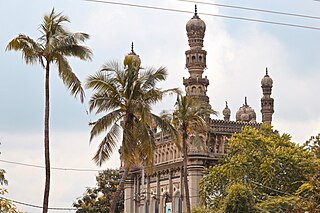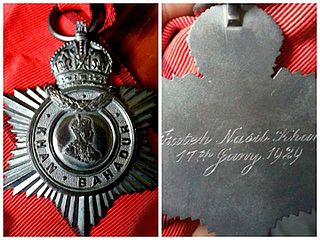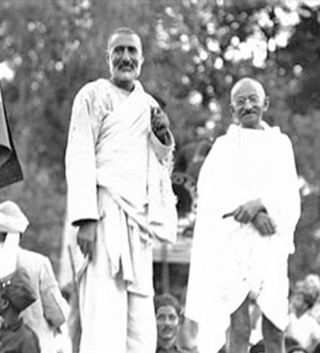
Sir Syed Ahmad KhanKCSI was an Indian Muslim reformer, philosopher, and educationist in nineteenth-century British India. Though initially espousing Hindu–Muslim unity, he became the pioneer of Muslim nationalism in India and is widely credited as the father of the two-nation theory, which formed the basis of the Pakistan movement. Born into a family with strong debts to the Mughal court, Ahmad studied science and the Quran within the court. He was awarded an honorary LLD from the University of Edinburgh in 1889.

Masjid-i-Jehan-Numa, commonly known as the Jama Masjid of Delhi, is one of the largest mosques in India.

Allauddin Khan, also known as Baba Allauddin Khan was an Indian sarod player and multi-instrumentalist, composer and one of the most notable music teachers of the 20th century in Indian classical music. For a generation many of his students, across different instruments like sitar and violin, dominated Hindustani classical and became some of the most famous exponents of the form ever, including Ravi Shankar and Ali Akbar Khan.

Asaduddin Owaisi is an Indian politician, who is the President of the All India Majlis-e-Ittehadul Muslimeen (AIMIM). He is a 4 time Member of Parliament (MP), representing the Hyderabad constituency in Lok Sabha, the lower house of the Indian Parliament. For years, he has been regularly listed by Royal Islamic Strategic Studies Centre (RISSC), among the 500 Most Influential Muslims of the world.

Bhopal State was an Islamic principality founded in the beginning of 18th-century India by the Afghan Mughal noble Dost Muhammad Khan. It was a tributary state during 18th century, a princely salute state with 19-gun salute in a subsidiary alliance with British India from 1818 to 1947, and an independent state from 1947 to 1949. Islamnagar was founded and served as the State's first capital, which was later shifted to the city of Bhopal.

Hyderabadi Muslims, also referred to as Hyderabadis are a community of Deccani people, who are part of a larger ethnic group of Urdu-speaking Muslims, from the area that used to be the princely state of Hyderabad in the regions of Marathwada, Telangana, and Kalyana-Karnataka.

Mir Farqunda Ali Khan commonly known as Nasir-ud-Daulah, was Nizam of Hyderabad, a princely state of British India, from 24 May 1829 until his death in 1857.

Sir Mir Turab Ali Khan, Salar Jung I,, known simply as Salar Jung I, was an Indian nobleman who served as Prime Minister of Hyderabad State between 1853 until his death in 1883. He also served as regent for the sixth Nizam, Asaf Jah VI between 1869 and 1883.

The Asaf Jahi was a Muslim dynasty that ruled the Hyderabad State. The family came to India in the late 17th century and became employees of the Mughal Empire. They were great patrons of Persian culture, language, and literature, and the family found ready patronage.

Koti Residency or British Residency or "Hyderabad Residency" is an opulent mansion built by James Achilles Kirkpatrick in the princely state of Hyderabad. Kirkpatrick was British Resident of Hyderabad between 1798 and 1805. It is a minor tourist attraction located in the suburb of Koti, Hyderabad.

Toli Masjid, also known as Damri Masjid, is a mosque in Karwan, Hyderabad, India. It is 2 km from the Golconda fort on the way to Charminar. Built by Mir Musa Khan Mahaldar during the reign of Abdullah Qutb Shah in. This mosque is INTACH awarded and a declared heritage site by Archaeological Survey of India. On scale of architecture Toli Mosque ranks next after Mecca Masjid, Hyderabad, India.
Turrebaz Khan was an Indian revolutionary who fought against the British in Hyderabad State during the Indian Rebellion of 1857 and was hung by the British.
Hyderabad was the capital of the Indian states of Telangana and Andhra Pradesh. It is a historic city noted for its many monuments, temples, mosques and bazaars. A multitude of influences has shaped the character of the city in the last 400 years.

The history of Telangana, located on the high Deccan Plateau, includes its being ruled by the Satavahana Dynasty, the Kakatiya Dynasty (1083–1323), the Musunuri Nayaks (1326–1356), the Delhi Sultanate, the Bahmani Sultanate (1347–1512), Golconda Sultanate (1512–1687) and Asaf Jahi dynasty (1724-1950).

Khan Bahadur – a compound of khan ('leader') and bahadur ('brave') – was a formal title of respect and honor, which was conferred exclusively on Muslim and other non-Hindu natives of British India. It was one degree higher than the title of Khan Sahib.
Ahmadullah Shah famous as Maulvi of Faizabad, famous freedom fighter and was a leader of the Indian Rebellion of 1857. Maulavi Ahmadullah Shah was known as the Lighthouse of Rebellion in Awadh region. British officers like George Bruce Malleson and Thomas Seaton made mentions about the courage, valour, personal and organizational capabilities of Ahmadullah. G. B. Malleson mentions Ahmadullah repeatedly in the History of Indian Mutiny, a book written in 6 volumes covering Indian revolt of 1857. Thomas Seaton describes Ahmadullah Shah as:
A man of great abilities, of undaunted courage, of stern determination, and by far the best soldier among the rebels.

Hindu–Muslim unity is a religiopolitical concept in the Indian subcontinent which stresses members of the two largest faith groups there, Hindus and Muslims, working together for the common good. The concept was championed by various persons, such as leaders in the Indian independence movement, namely Mahatma Gandhi and Khan Abdul Ghaffar Khan, as well as by political parties and movements, such as the Indian National Congress, Khudai Khidmatgar and All India Azad Muslim Conference. Those who opposed the partition of colonial India often adhered to the doctrine of composite nationalism.

A distinct Indo-Islamic architecture style with local contribution is reflected in the historical buildings of Hyderabad, making it the first and "Best Heritage City of India" as of March 2012. The city houses many famous historical sites constructed during Qutb Shahi and Asaf Jahi period, including various mosques and palaces.

The Mazumders of Sylhet, or more specifically, the Mazumders of Gorduar/Barshala, are a notable aristocratic family who have played important roles throughout the history of the Sylhet region.

















